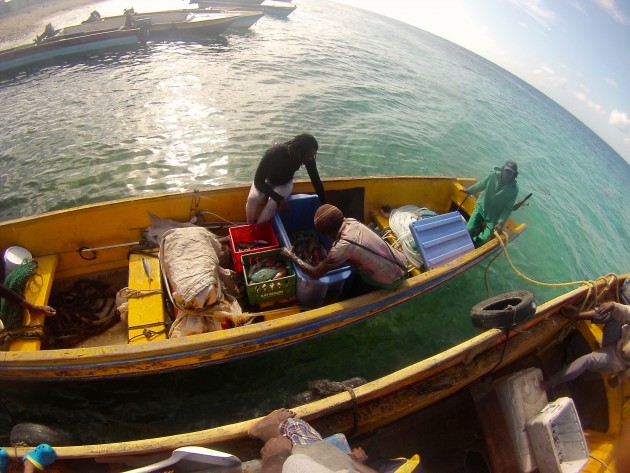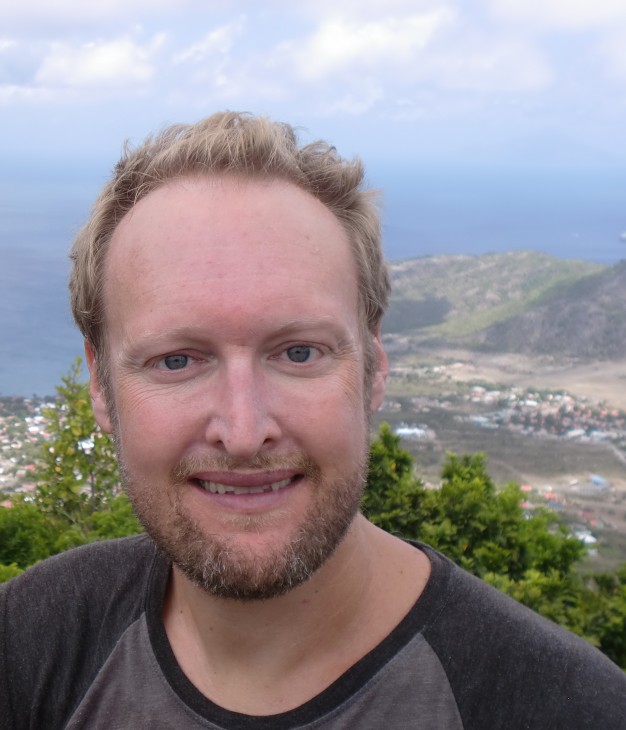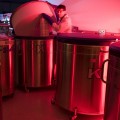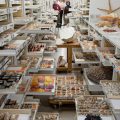By Maria Anderson

Nathan Truelove and Candice Brittain (Applied Scientific Research Department Head, The Cape Eleuthera Institute) process DNA samples from queen conch in the Bahamas. (Photo by Roderic Hodges)
Smothered in tartar sauce and cheese it’s difficult to know just what species of fish lurks beneath the breaded surface of a fast-food fish sandwich. Likewise for much of the fish ordered at even the finest restaurants.
Equally important to knowing the type of fish you are eating, says Nathan Truelove, postdoctoral fellow in the Marine Conservation Program at the Smithsonian Marine Station in Fort Pierce, Fl., is knowing just where it was caught. Tragically, illegal, unreported and unregulated fishing is one of the greatest threats to many commercial fish species around the world.
Recently, Truelove has been using genetic sequencing to try and address this problem for two species from the Caribbean: spiny lobster and queen conch. Here we ask Truelove a few questions about his work to protect these animals from being taken illegally from the sea.
Q: How did you begin researching where seafood comes from?
Truelove: Part of my research as a Ph.D. student was to determine how closely different populations of spiny lobsters across the Caribbean were related to one another, specifically populations off the coasts of Honduras, Belize and Mexico. I wanted to determine whether there was enough of a difference genetically to distinguish between these populations.

Caribbean spiny lobster (Flickr photo by Eric Littman)
After a lobster’s eggs hatch, ocean currents can carry their larvae for several months. This means that populations found in different regions of the Caribbean, even though separated by thousands of miles, can be closely related. For example, a lobster found off the coast of Honduras can be very closely related to a lobster from Belize.
As there is so much interconnectivity between different populations of spiny lobster in the Caribbean, I realized I could not use this part of an animal’s genetic ID to determine where it was caught.
Q: Why is it important to know where seafood comes from?
Truelove: Determining where seafood comes from is crucial to manage species and to prevent illegal, unreported and unregulated (IUU) fishing on marine fisheries. This information could help enforcement agencies minimize IUU fishing.
A lot of the spiny lobster and queen conch production in the Caribbean comes from off shore fishing banks of Honduras, Belize and Jamaica. Fishing is the prime economic driver for fishing communities in remote coastal areas that make their living working on large fishing boats.
One problem in these offshore areas is that fishing vessels from one country can illegally poach and take the lobster and conch from waters of a neighboring country. Once they do that, it is impossible to tell if the seafood on board originated legally from a country’s own waters, or if it was taken illegally from some other location.

Fishers from Pedro Bank Jamaica returning home with their catch. (Photo by Courtney Cox)
In the case of queen conch, the issue is also a matter of international conservation efforts since queen conch is protected under the Convention on International Trade in Endangered Species of Wild Fauna and Flora (CITES). CITES is an international agreement between governments, dedicated to ensure that international trade in wild animals and plants does not threaten the survival of these species.
CITES has ceased fishing and imposed quotas in some Caribbean queen conch fisheries, so there is a great need to accurately monitor where queen conch offered for sale as seafood has actually been fished.
Q: What research tools are you using?
Truelove: Currently the way we determine where seafood comes from is through catch data, which states a country’s annual production and country of origin. But this information can mask how much of that catch originated outside of its territorial waters. In areas with limited enforcement capabilities at sea, illegal fishing is a significant problem with seafood marked as coming from one country perhaps having originated somewhere else.
Since I knew that interconnectivity would be insufficient to accurately trace seafood provenance, I’ve focused on using new genetic sequencing techniques to determine traceability.

Queen conch juveniles being collected for DNA analysis. (Photo by Catherine Booker)
I got my inspiration from a project in the European Union called FishPopTrace, which uses high-resolution DNA sequencing to pinpoint the specific genes necessary for local adaptation. Marine environments have a lot of variation in temperature, water salinity, dissolved oxygen, etc., and animals must adapt to these conditions in order to survive. Over time these adaptations leave a mark in the animal’s genetic code, which can be detected using DNA sequencing tools.
Once genes responsible for local adaptation are isolated, we can trace an animal back to a specific geographic area. With this level of detailed information we can determine more precisely where seafood comes from.
Q: How did you collect the voucher samples for the DNA testing?
Truelove: Very carefully! Especially in the case of queen conch, since it’s a CITES-protected species. When collecting samples from queen conch in the wild the last thing I want to do is cause a negative impact to local populations. I had to come up with a technique that was the least invasive, causing the least amount of stress to the conch, while still taking a sufficient amount of tissue for DNA testing

Queen conch from the Bahamas. The foot, located at the bottom of the photo, is a strong muscle that it uses to move around on the sea floor. The conch’s two eyes are located above the foot and its mouth is located just above its eyes. The mantle, located in right hand corner of the photo, is the organ that creates the conch’s shell and is orange and black in color. (Photo by Catherine Booker).
I used surgical biopsy forceps to take a small piece of tissue off the mantle, which is the organ from which the queen conch secretes its shell. Briefly taking the queen conch out of the water, I removed a piece of tissue no more than the size of a fingernail clipping. From that we were able to extract enough material to do the level of DNA sequencing we need and the conch was then released alive and unharmed.
Q: What is the next step in the project?
Truelove: So far we’ve extracted the genetic material needed for the DNA sequencing from conch and spiny lobster living in different countries in the Caribbean. The next step is sequencing the samples that we’ve collected and analyzing them, a process that requires the joint efforts of the Smithsonian Institute for Biodiversity Genomics, the Smithsonian Global Genome Initiative and researchers at Stanford University, who have pioneered the DNA sequencing technique used to determine local adaptation. It’s great that we have so many partners and resources that can help us solve this problem.

Nathan Truelove in St. Eustatius, Caribbean Netherlands. (Photo by Susan Bennett)
Q: How will you be able to use this information for traceability?
Truelove: The goal is to gather enough information to be able to trace a conch or a lobster back to a specific country, or even an area within a country’s waters. This can help enforcement agencies better understand IUU fishing and help local fishers more effectively manage their fisheries. It can also be useful in the design of marine protected areas, since we may be able to pinpoint whether seafood comes from an area where fishing is closed or open at any given time.
Q: Why is this project important to you?
Truelove: I’m particularly proud of this project because we’re taking Smithsonian science and applying it to real life problems. We’re helping communities that depend on fishing as their main source of income and that are affected by IUU fishing. Working closely with these communities is one of the most rewarding parts of my research.





